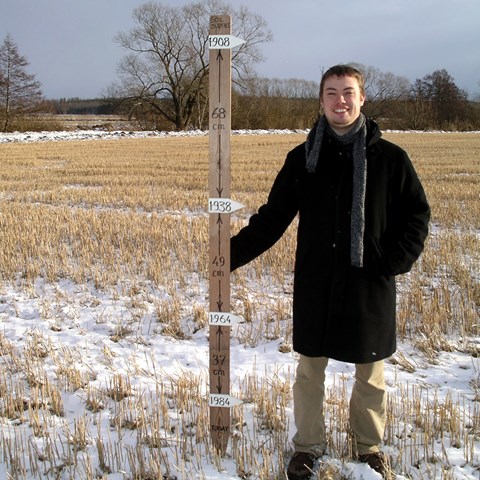Contact
Örjan Berglund, Researcher
Department of Soil and Environment, SLU
orjan.berglund@slu.se, +46 18671186
Department of Soil and Environment, Agricultural water management

Within the field of agricultural water management, there are long-term field experiments in the sub-areas of organic soil and land drainage. All experiments are situated at private farms because the soil type is decisive for the choice of experiment site.
Drainage of peat soils increase soil aeration and the oxidation of the organic material gives rise to both carbon dioxide and nitrous oxide emissions. The focus of the trials at Field lab Broddbo on organic soil (fen peat) is to find measures that limit greenhouse gas emissions while maintaining or increasing biomass production.
At the site there are four long-term trials with start years 1986-2017 as well as short-term field trials financed with external funds. The oldest experiment is the Örke subsidence trial which started in 1986 and the others are, one experiment with different grasses combined with compaction, one with the addition of sand and one liming experiment.
In all field trials is biomass production measured with two silage harvests per year. In addition, climate data, soil water content, soil temperature and groundwater levels are measured. Other factors such as greenhouse gas emissions and trafficability are measured if external projects provide funding.
Contact: Örjan Berglund, researcher, Dept. of Soil and Environment, orjan.berglund@slu.se, +4618673495
The experimental site was established in 2000 at Gärds Köpinge, (southeast Sweden, in the county of Skåne (55o56’N, 14o10’E). It has been a long-term experiment since 2009. The study area has a semi-humid climate with a mean annual air temperature of 7.6 oC (using 1961–1990 data from a meteorological network station at Kristianstad).
Two months (January and February) have a mean air temperature below zero degrees (Alexandersson et al., 1991). The mean annual precipitation is 562 mm. At the site, the topsoil (0–40 cm) is a weakly structured loamy sand with an organic matter content of five percent. The subsoil (40–100 cm) is a sand with low organic matter content, which restricts the main microbiological activity to the topsoil. Below 1 m depth, there is a clay layer, which effectively restricts downward seepage.
The experimental site is divided into four plots, including two plots with conventional subsurface drainage and two plots with controlled drainage. The plot size was 36 m x 40 m. Each plot is drained separately by four parallel lateral drains spaced 9 m apart. Plastic sheeting to a depth of 1.6 m to prevent lateral leakage and subsurface interactions isolates the plots. The outlets were connected to a weir allowing the groundwater to potentially rise to a pre-selected minimum height, after which outflow occurred. All plots are incorporated into an ordinary Swedish conventional farming system.
Contact: Ingrid Wesström, Senior Lecturer, Dept. of Soil and Environment, ingrid.wesstrom@slu.se, +4618673492
A clear strategy for adapting agricultural drainage to climate change is important for environmental and economic reasons. In this project with the overall aim of developing recommendations for future drainage of clay soils, we are studying how re-drainage affects nutrient leaching and crop yield, and in particular the impact of drain spacing (with/without lime filter) on nitrogen and phosphorus losses and crop yield.
Re-drainage has been studied since 2019 in a field experiment (clay soil) at Gölja, Västmanland (59o48’26’’N 16o47’09’’E). The field trial consists of 12 randomized individually drained plots allocated to four treatments (A-D, each with three replicates): A) clay tiles, 10 m drain spacing; B) plastic pipes, 10 m drain spacing; C) plastic pipes, 5 m drain spacing; and D) plastic pipes, 10 m drain spacing plus lime incorporation in trench backfill.
Flow measurement and flow-proportional logger-controlled water sampling on subsurface runoff from each individual plot are performed at a measuring station. The farmer conventionally manages the field trial.
Contact: Ingrid Wesström, Senior Lecturer, Dept. of Soil and Environment, ingrid.wesstrom@slu.se, +4618673492
Overview of long-term field experiments in agricultural water management |
||
|
Series (number of trials) |
Start (year) |
Sites and coordinates |
|
Field lab Broddbo, organic soil. Four field trials; Subsidence, grass types/compaction, sand addition and liming experiments |
1986-2017 |
Broddbo, Uppsala county (60°1’40’’N, 17°25’47’’E) |
|
R1-150 Controlled drainage. One trial with two treatments |
2009 |
Gärds Köpinge, Skåne county (55o56’N, 14o10’E) |
|
L1-151 Subsurface drainage. One trial with four treatments |
2019 |
Gölja, Västmanlands county, (59o48’26’’N 16o47’09’’E) |
Örjan Berglund, Researcher
Department of Soil and Environment, SLU
orjan.berglund@slu.se, +46 18671186